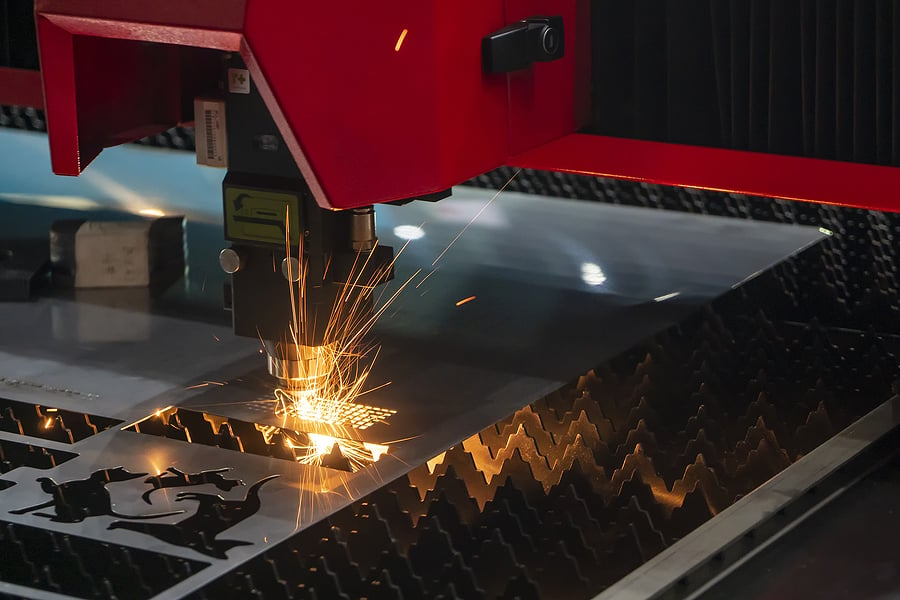The following will take a step back from IoT and machine data to see how engineering practices such as material selection and CAD can do more with less.
IoT, connected devices, and other technologies are driving digital manufacturing. However, accelerating design cycles and shorter product life cycles can create stress on production lines.
Starting a design may include basic GD&T, strength, and other requirements, making material and process selection easy.
Some companies have been able to get started with little more than some basic metalworking equipment. As early production increases, it justifies the purchases of CNC and injection molding equipment.

CNC and injection molding equipment in use.
Today, reduced product life-cycles and customization creates more complex challenges that make some materials or processes challenging to justify cost or tooling. Even hiring and finding talent to update designs and CNC programming is becoming a more complicated and increasing cost.
A holistic view is essential when considering material selection to satisfy production needs. Some key factors are:
- Faster processing times
- Other departments
- Supply chain management
- CAD and generative design
Faster Processing Time
Processing times are often set. While adjusting speed and feed rates on a CNC machine might be possible, consider if this action would increase maintenance or damage the machine. Changing process speed can create more of a liability than an asset.
However, changing materials, if possible, may allow for higher speed and feed rates without increasing downtime.
Another change is in molded materials. Some industries have switched from thermosets to thermoplastics. Changing from a thermoset or thermoplastic could save minutes in hold times per part.
To compensate for any difference in strength, companies have added glass or carbon fiber to thermoplastic parts to create a composite. It will be important to consider how the fibers increase wears on tooling and how a thermoplastic may change the product’s life-cycle in the design process.
Composites have been associated with high labor costs and chemicals sensitive to time, temperatures, and other environmental factors. Some composite chemicals are designed to work for an eight-hour shift.
This time means each shift a worker needs to clean vats, hoses, rollers, etc. that take them away from workable hours – the time work is being done on a product which doesn’t include downtime, cleanup, lunch breaks, etc.
Prepreg composites can decrease labor, processing times, clean up times, and produce higher quality products. These benefits cost more than traditional composites, but viewing it from a holistic approach, prepreg-composite have yielded more significant ROIs.
However, unless you are designing for an application that can justify the time, it can be difficult for composites to compete.

The fiber laser cutting machine cutting the sheet metal plate.
For example, be aware of bottlenecks. If sheet metal equipment can stamp or fold a single part in less than a minute, even taking five minutes to make the same part with composites will create a bottleneck. This is where knowing what is happening in other departments can help guide companies towards different materials and processes.
Other Departments
Part of a holistic approach is knowing or accurately predicting customer demand. Compared to orders, expected sales, or finding the time, taking workable hours will yield a time per part each product will need to be produced within.
This time sets the pace of production, or what deadlines production can meet. Having this data on hand may help manage marketing and sales teams more effectively with manufacturing.
When it comes to materials, understanding inventory and accounting practices add to the holistic manufacturing approach. If a material can reduce inventory, it could also reduce the number of times workers spend tracking or documenting inventory.
This may also reduce the number of purchase orders accounting processes. The more items that need to be tracked, processed, counted, or documented can save time in both the factory and the office.
Supply Chain Management
In addition to inventory, if a feedstock requires a long lead time from suppliers, supply chain management and inventory controls could disrupt manufacturing. Selecting a common material that is easily accessible from multiple vendors gives production options.
A custom material or one with limited vendors can leave companies vulnerable or at the mercy of a single entity.
There have been cases where politics, natural disasters, corporate buyouts, and even changes to delivery routes have disrupted materials flow. The amount of material needed to scale is available or is accessible from multiple suppliers should also be considered to keep manufacturing moving.
CAD and Generative Design
Material selection can affect everything from the start of the supply chain, inventory, processing times, and final product. Engineers might only consider design specifications, but decision-makers should be aware of the bigger picture to find the best holistic solution.
Software and CAD have provided tools that can track a bill of materials, inventory digitally, and even change design materials. This technology is helping to amplify an engineer’s ability and promote communication and information access across departments.
Going a step further, generative design tools in CAD can show all possible materials for a specific design specification. Engineers may already have an idea to which geometries, materials, and processes to use for their particular industry, resources, etc.
However, knowing all possible materials options and how that would affect design helps engineers pivot to materials that could improve the design for manufacturing, help in times of material shortages, or in events that cause a shift in the supply chain.
Designing with a holistic approach can help prevent employees from becoming overworked while trying to meet goals or lead times that may not be possible under the production’s current restraints.
Technology with easy to understand and communicate data lets workers do their jobs better while seeing across verticals to better align with the company’s bigger picture.
Copyright Statement: The content of this website is intended for personal learning purposes only. If it infringes upon your copyright, please contact us for removal. Email: admin@eleok.com
